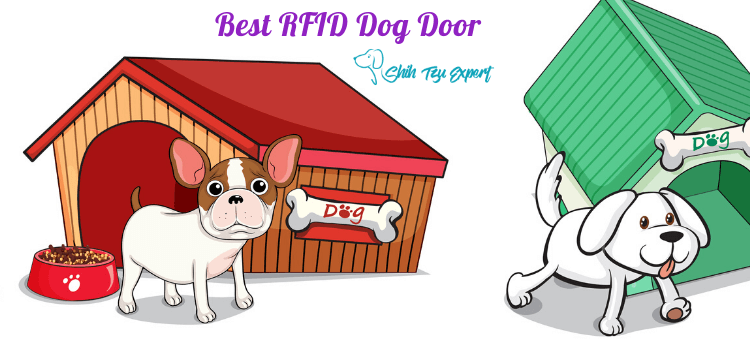
Every pet owner wants to put their furry friend first, but sometimes it can be annoying when your pet wants to go in and out all day long. For people who have a fenced-in yard, one solution is to install a pet door that allows the pet to come and go as they please, but then how can you make sure other animals don’t get in? Using a pet door that’s equipped with an RFID reader means you don’t need to worry about anyone else – human or animal – being able to access the door.
If you’re looking for the best automatic dog door chip technology, here are some details about top-rated RFID dog doors that can help with your decision.

What is an RFID Dog Door?
Some RFID activated dog doors will open automatically when the pet approaches, while others just unlock and the pet needs to push the door manually. The advantage of using RFID chip technology for a pet door is to restrict access to your pet only.
RFID Dog Door vs Standard Dog Door: Which is Right for You?
An RFID dog door might be right for you if you live in an area with a lot of wildlife that could enter your house using a standard dog door. If you have a larger dog that needs a door size that a human could use, you could be exposing yourself to potential break-ins by using a standard dog door in an area that people can access. It’s also useful if you have multiple pets but you only want some of them to be able to use the door, and don’t forget that children could also use a standard pet door to get outside when you’re not looking. Finally, an RFID dog door that also opens automatically might be a good choice if you have a pet that has been hesitant to push open a standard dog door.
Are RFID Dog Doors Energy efficient?
The short answer is – yes! In addition to the convenience they provide to owners, buying an RFID dog door usually saves the household energy because they’re no longer opening a human-sized door multiple times a day. However, any installation of a pet door means cutting a hole in a door or wall of your home, so if the door itself is not well insulated, it can let in drafts and hot or cold temperatures that you’re trying to avoid. Pet door manufacturers are well aware of this issue, so they’re constantly working to improve the materials used to construct their products in order to get the best combination of insulation, usability, and price. Here are a few considerations to keep in mind when deciding which dog door is going to meet your energy efficiency needs:
Length of time the door opens/closes: Does it stay open long after your pet has gone through? Every second the door stays open can cost in heating and cooling bills. Also some more sensitive RFID transmitters have been known to trigger even when the pet is just wandering nearby. You can avoid this problem if you choose a door with directional sensing that only activates if the pet is approaching the door.
Material: Every RFID dog door is made of a door panel, which is the part that moves, and a unit that holds the door panel in place and contains the electronic elements. Most units are made of metal or some type of plastic material, while most door panels are plastic. Well-made RFID pet doors will be well-insulated and designed to minimize gaps between the door panel and the unit. They should use lightweight but thick materials to maximize energy efficiency.
Location: Consider where on your home you decide to place the RFID dog door. Based on the climate where you live, you might want to avoid certain directions for your door, for example the north side of your home could be more exposed to cold winds than the south side. In hot climates, it may make sense to find an installation area that is not exposed to direct harsh sunlight that could damage the door.

How do you install an RFID dog door?
Installation will vary somewhat between models, but you will usually find that the RFID dog door has two installation options – in a door or in a wall. Between these two, the door is the simpler option, but the best choice will depend on a variety of factors unique to your home. It may be necessary to hire someone to help with installation if you do not have the correct tools or knowledge to perform the installation yourself.
For wall installations, you’ll usually need to purchase one or more extension tunnel kits. These provide a structure for the RFID dog door to sit inside, and account for the extra thickness of a wall vs a door. Consult the instruction manual in order to find the ideal placement for the wall tunnel. Then you’ll mark the area using a template and drill through both the interior and exterior walls in each of the four corners. Then use a jigsaw to cut the hole in the interior wall. After that, you’ll use the same process to cut through the exterior wall using your drill holes and the template to guide you. After that, you can install the tunnel pieces and the pet door following the guidance in the manual.
If your RFID dog door will have a hardwire electrical connection, there will be additional steps and a licensed technician should be hired to perform this work.
Installing an RFID dog door is not the simplest DIY project, and it does require some tools to be performed correctly. Always be safe, and consult with a professional if you’re not sure about any steps in the process. Most companies manufacturing pet doors also have customer support available by phone, so you can connect with them for assistance.
What to look for in an RFID Dog Door
Since there are a lot of options for RFID pet doors, you may feel overwhelmed when trying to decide which is right for you. Here are some factors to consider when making your decision:
Number and size of pets
If multiple pets will be using the door, you’ll want to choose the size that accommodates the largest of them, but won’t be too heavy for the smallest to operate. Some RFID dog doors have a limit as to how many devices can be programmed to access the door, so be sure that you have plenty of space to add more if needed.
Construction material
The material used to construct the RFID dog door will make a difference to the energy efficiency and security of the door. Doors made from inferior materials may degrade over time and stop working.
Installation
Check the instructions before purchasing to make sure you have everything needed to do the installation yourself, or check in with a professional who can install it for you. Consider the location to install before you purchase, and make sure the door size will fit.
Security
Microchip
If your pet already has an RFID microchip, it may make the most sense to look into an RFID dog door that works with that technology. This saves money on batteries and also means you won’t have to worry about the transmitter falling off or breaking, which could trap your pet inside or outside accidentally.
On-going Costs and Durability
Obviously you’ll consider the initial price of the RFID Dog Door you’re considering, but it’s also important to consider additional costs that can add up over time. On-going costs include replacement batteries and collar keys. Less durable units may cost less up-front, but cost more over time when you have to replace them every couple of years. Unfortunately there’s no standard size of hole for pet doors, so you may be locked into a particular brand if that’s the only size that can be installed in the hole in your house.
Direct Sensing System
Remote Access Control
Most RFID dog doors allow the owner to control access to the dog door using different modes such as In Only, Out Only, Locked, Unlocked. In some models, this can be remotely changed by using an app on the user’s mobile phone. This feature might be important to you if you’re sometimes away from home but want to control where your pet is allowed to go.
Programmability
Certain RFID dog doors offer extra programming options and timers so you can set and forget your pet’s access. Similar to remote access control, this option for the pet owner frees them to determine what their pet can do even when the owner is not home. If you unexpectedly had to work late one night, for example, no problem – you can program the door to unlock and allow your dog out and rest assured that he won’t have an “accident” in the house.
Children
With these factors in mind, here are several models offering a variety of features to fit your needs:
Plexidor Large Door Mount PDE Electronic Pet Door in White
Made by PlexiDor Performance Pet Doors
Best Luxury/High End RFID Dog Door + Best RFID Dog Door Overall
The Plexidor Electronic Pet Door offers a luxury experience for your pet. They don’t have to manually operate the door by pushing through with their body, which many dogs and cats dislike doing. Instead, your pet just approaches the door and it will automatically open for them. It’s convenient for pets and owners alike.
The PlexiDor Electronic Dog Door features a composite panel that slides vertically in its housing when your pet approaches wearing the pre-programmed RFID key on its collar. It only works with your pet’s key, so even if your neighbor has the same model, their dog or cat wouldn’t be able to access your home. This door is top-of-the-line when it comes to security and features.
This is best for:
Pet owners who are willing to spend more to get the best. People with large dogs who worry about the security of a standard dog door. Households where the pets dislike opening the door manually.
Features:
Easy to program
Ships with two RFID collar keys
Option to power with standard electrical outlet or hardwired installation
Alarm alerts you to obstacles blocking the door or attempts to force the door open
Large size can accommodate pets up to 125 pounds
Pet and child safe
Made in the USA
Unconditional 90-day satisfaction guarantee and 5 year limited warranty included
Benefits:
This Plexidor Large Door Mount PDE Electronic Pet Door is safe for pets and children, because it has safety features that prevent it from closing when there’s any obstruction in the way. The RFID collar key operates the door for your pet only, keeping out unwanted pests. Also this RFID chip will not interfere with other electronic systems you might have, like home security alarms or invisible fences.
Another benefit of this over other models is that this Electronic Pet Door allows you to program how long the door stays open based on your pets’ habits. For example, if your dog is older and takes some time to get through the door, you can adjust the opening time to allow him to go through at a leisurely pace.
Pros:
RFID collar keys do not require batteries, keeping replacement costs down long-term
Metal housing and strong composite material door for security
Can be used by large pets
Weatherproof
Elegant appearance
Lightweight (0.4 ounces), small, and durable collar keys suitable for any size pet
Cons:
Expensive
Taller profile because of the vertical door panel action
Only one large size
No option for battery or battery-backup power
Noisy when opening and closing
Things to Be Aware Of
PlexiDor recommends using a surge protector with this door, since power surges may cause damage to the circuit board and/or electrical components. Although homeowners have the option of a hardwired or AC power supply, any hardwired installation should only be performed by a licensed electrician.
The MUST Know, True Facts:
Some users of this product have noted that their dog needed to be very close to the door in order to cause the door to open. This is usually caused by some interference with the antenna that is causing it not to get enough power. Metal tags on the pet’s collar can also block the signal. The US-based customer service team is available to help with troubleshooting and can guide you through the process of getting this and other issues resolved.
Conclusion:
With dozens of positive reviews, including some from customers who have had this door for ten years or more, it’s easy to see why this product is a winner overall for customers looking for the best RFID dog door. PlexiDor’s customer service and replacement parts also get high praise from their customers. For those who can afford the high price tag, the Plexidor Large Door Mount PDE Electronic Pet Door is a great investment that lives up to its potential.
PlexiDor Performance Pet Doors Electronic RFID Collar Key for Use with Electronic Door – Black
Made by PlexiDor Performance Pet Doors
Best RFID Dog Door Accessory
The PlexiDor Performance Pet Doors Electronic RFID Collar Key for Use with Electronic Door is the partner product to the Plexidor Large Door Mount PDE Electronic Pet Door. It contains a micro-RFID chip to be used with PlexiDor brand electronic pet doors. It can be programmed to match your door’s key code. This Collar Key is designed to be durable and will not fall off your pet’s collar. It can stand up to playful dogs and it is even waterproof, so if your dog likes to swim, you don’t need to worry about it getting damaged.
This is best for:
Multi-pet households that have a PlexiDor Electronic Pet Door installed. Pet owners who need backup or replacement RFID Collar Keys for their PlexiDor Dog Door.
Features:
Range of 12” to 15”
Sized for both dogs and cats at 1 7/8” x 1 3/16”
Lightweight at 0.4 ounces
Benefits:
Unlike magnetic-based entry systems, using these RFID key collars will not leave your home vulnerable to anyone who happens to have a magnet. These collar keys are well-designed and fit to purpose.
Pros:
Lightweight, small, and durable
Can be used by any size pet
Waterproof
Shock proof – will not injure your pet
Affordable
Snaps onto your pet’s existing collar
Doesn’t interact with home security systems
No batteries
Cons:
Only works with PlexiDor products
Things to Be Aware Of:
This collar works with the PlexiDor PDE Door unit or the PDE Wall unit. It is not intended for use with any other RFID dog door.
The MUST Know, True Facts:
The Plexidor Electronic Pet Door can remember up to ten keys. If you have replaced the key several times, you may run out of memory when attempting to program your new RFID Collar Key. The solution to this issue is to delete all the collar keys and reprogram them. Instructions can be found on the PlexiDor website.
Conclusion:
Like the Plexidor Electronic Pet Door, this product gets glowing reviews from its users who commend its durability, water resistance, and overall value.
PetSafe Interior and Exterior Cat Door – Microchip RFID Pet Door – 4-Way Locking – Big Cat – Works With up to 40 Programmed Pets


Best RFID Dog Door for Small Breed Dogs
Best Budget RFID Dog Door
Best RFID Dog Door for Multi-pet Homes
This is best for:
Households where all pets are small and already have microchips. Multi-pet homes. Pets that dislike wearing collars.
Features:
Manual four-way lock allows you to limit your pets’ access whenever you like
Works with your pet’s existing microchip ID
Can be programmed for up to 40 pets
Can be used on interior or exterior doors
Benefits:
This door features a locking mechanism that you can set to keep your pet safe. You can set it to Locked, Unlocked, Exit Only, or Enter Only. Use the manual lock if you want to allow your pet to use the door only when you’re home, for example, or to keep them inside once they come in for the night.
Pros:
No need for separate transmitter; works with implanted microchips
Large capacity for multi-pet homes
UV sun protection for energy efficiency
Insulated with weather stripping to stop drafts
Operates with standard AA batteries
Toll-free customer service phone number available for US customers
Cons:
Difficult installation
Can only accommodate smaller dogs
Door sticks open
Quality issues – plastic is easily damaged or broken
Manual lock is hard to lock and unlock
Things to Be Aware Of
Some cat owners who used this product complained that their cat was able to open the door from the inside, even when it was set to “In Only” by hooking their claws under the door and pulling it in. This is unlikely to be a problem for dog owners who choose the PetSafe MicroChip RFID Pet Door.
Many customers also complained about the noise of this door. When the pet approaches and the lock disengages, it makes a clicking sound that can frighten some animals. The build quality and durability were also considered to be subpar, although this is on the cheaper side of RFID activated pet doors.
The MUST Know, True Facts:
You should be aware that this door reads only FDX-B 15-digit chip IDs. This is the most common type of microchip implanted in dogs and cats, but if your pet has a different type it will not interact with this door. Programmable collar keys are available to purchase separately for pets that do not have microchips implanted.
Summary:
PetSafe Interior and Exterior Cat Door – Microchip RFID Pet Door – 4-Way Locking – Big Cat is a great option for budget-conscious customers who want the convenience and security of having an RFID dog door available for their small pets. This item avoids many of the issues with fragile or lost collar transmitters by working directly with RFID microchips already implanted in pets. However, they should be aware of the quality issues around the material of this door, and also note that sensitive pets may not adjust to the noise of this RFID pet door.
PetSafe Electronic SmartDoor – Collar Activated Dog and Cat Door – Small to Large Pets
Best RFID Dog Door for Extra Large Pets
PetSafe has been designing and manufacturing pet products since 1991, and they offer a toll-free customer service number for customers in the US so you can feel confident that they will be available to support you if you encounter any issues with their products.
This is best for:
Owners of large dogs that might not fit through other dog doors. People looking for an affordable semi-automated dog door system.
Features:
Includes one SmartKey
Battery indicator light
Programmable to lock when not being used
Ready for door installation; wall installation with conversion kit
Can be used with up to five pets
Battery operated
Detailed installation and troubleshooting manual included
Benefits:
Reasonable price for an RFID Dog Door that can accommodate larger pets. Has a modern, unobtrusive look that blends in with a room. Easy to install and operate.
Pros:
Door unit is powered by standard D-cell batteries
Waterproof SmartKey included
One year warranty
Easy installation
Customer service phone numbers available for the US, Australia, and New Zealand
Cons:
Noisy
Operates slowly
Short battery life
SmartKeys are too bulky and large, especially on smaller dogs
SmartKeys are not durable
Batteries fall out of SmartKeys
SmartKey batteries are proprietary
Plastic hinges are not durable and doors break off
Doors open and close inconsistently
Not well insulated
Things to Be Aware Of
Because of the closure mechanism of this door, some dogs with longer tails may get their tails caught in this door when they go through. Unlike some other microchip dog doors (for example, the Plexidor Large Door Mount PDE Electronic Pet Door in White), this model does not offer any option to adjust the amount of time the door opens and closes.
Some users report that the door will open and close even when their pet is nowhere near the door, or that the door wouldn’t open even when the SmartKey is right in front of it. It is slow to register that the pet is in or out of range of the door.
The MUST Know, True Facts:
PetSafe advises that this product not be installed near large metal appliances or in metal doors, as they may interfere with the signal. Installing the PetSafe Electronic SmartDoor – Collar Activated Dog and Cat Door in a laundry room or kitchen will probably cause issues with the SmartKey.
Make sure to install this door at an appropriate height for your pet as detailed in the instruction manual. A door installed too low can cause the pet to hit his or her back, possibly damaging the door or injuring the pet.
Summary:
When this door works well, dog owners love it. Unfortunately, for some people it does not function correctly and causes frustration. When considering whether or not to purchase this door for your pets, it’s advisable to consider your dog’s size, sensitivity to noise, and aggressiveness, as well as whether you’d be installing it in a location that might invite unwanted attention from potential burglars.
![Custom shape wireless dog fence [Electric Fencing and Electric Barrier Systems] Custom shape wireless dog fence [Electric Fencing and Electric Barrier Systems]](https://shihtzuexpert.com/wp-content/uploads/2019/07/Custom-Shape-Wireless-Dog-Fence-Review.png)
![10 Best Dog Crates for Separation Anxiety [High anxiety dog crates 2019 Reviews] 10 Best Dog Crates for Separation Anxiety [High anxiety dog crates 2019 Reviews]](https://shihtzuexpert.com/wp-content/uploads/2019/05/5-3.jpg)
![7 Best Dog Clippers for Professional Use [Ultimate Guide] 7 Best Dog Clippers for Professional Use [Ultimate Guide]](https://shihtzuexpert.com/wp-content/uploads/2018/06/Best-Dog-Clippers-1-1.png)






